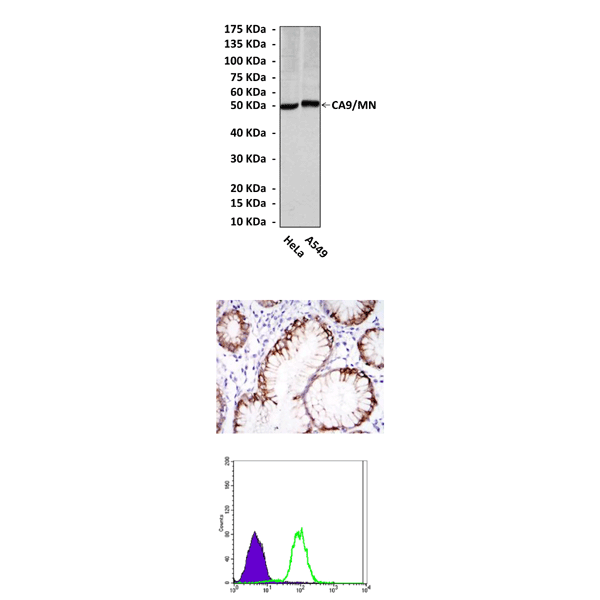Product Sheet CP10346
Description
BACKGROUND Carbonic anhydrases (CAs, EC 4.2.1.1) are a family of enzymes widespread in all life kingdoms. In mammals, isozyme CA9 is highly overexpressed in many cancer types being present in few normal tissues. CA9 is induced in response to low oxygen as a part of the hypoxic transcriptome. Its expression is strongly induced by hypoxia present in many tumors, being regulated by the HIF transcription factor. Moreover, CA9 serves as a surrogate marker of hypoxia and prognostic indicator. Its expression is strongly linked to different types of tumors with the HIF pathway activated due to genetic defect or physiological hypoxia, and correlated with a poor response to classical chemo- and radiotherapies.1
Cells of the growing tumor tissue are exposed to physiological stresses connected with insufficient delivery of oxygen (hypoxia) and accumulation of acidic products of the glycolytic metabolism (acidosis). Adaptation to these microenvironmental stresses involves remodeling of the cellular expression program mediated by hypoxia-inducible factor (HIF), which activates broad array of genes functionally involved in angiogenesis, anaerobic glycolysis, de-adhesion, invasion etc. This leads to increased aggressiveness of tumors, metastatic spread and poor response to therapy.2 CA9 was recently shown to contribute to acidification of the tumor environment, by efficiently catalyzing the hydration of carbon dioxide to bicarbonate and protons with its extracellularly situated active site, leading both to the acquisition of metastasic phenotypes and to chemoresistance with weakly basic anticancer drugs. Inhibition of this enzymatic activity by specific and potent inhibitors was shown to revert these acidification processes, establishing a clear-cut role of CA9 in tumorigenesis. The development of a wide range of potent and selective CA9 inhibitors belonging to diverse chemical classes, such as membrane-impermeant, fluorescent or metal-containing such agents, could thus provide useful tools for highlighting the exact role of CA9 in hypoxic cancers, to control the pH (im)balance of tumor cells, and to develop novel diagnostic or therapeutic applications for the management of tumors. Indeed, both fluorescent inhibitors or positively charged, membrane impermeant sulfonamides have been recently developed as potent CA9 inhibitors and used as proof-of-concept tools for demonstrating that CA9 constitutes a novel and interesting target for the anticancer drug development.3
Cells of the growing tumor tissue are exposed to physiological stresses connected with insufficient delivery of oxygen (hypoxia) and accumulation of acidic products of the glycolytic metabolism (acidosis). Adaptation to these microenvironmental stresses involves remodeling of the cellular expression program mediated by hypoxia-inducible factor (HIF), which activates broad array of genes functionally involved in angiogenesis, anaerobic glycolysis, de-adhesion, invasion etc. This leads to increased aggressiveness of tumors, metastatic spread and poor response to therapy.2 CA9 was recently shown to contribute to acidification of the tumor environment, by efficiently catalyzing the hydration of carbon dioxide to bicarbonate and protons with its extracellularly situated active site, leading both to the acquisition of metastasic phenotypes and to chemoresistance with weakly basic anticancer drugs. Inhibition of this enzymatic activity by specific and potent inhibitors was shown to revert these acidification processes, establishing a clear-cut role of CA9 in tumorigenesis. The development of a wide range of potent and selective CA9 inhibitors belonging to diverse chemical classes, such as membrane-impermeant, fluorescent or metal-containing such agents, could thus provide useful tools for highlighting the exact role of CA9 in hypoxic cancers, to control the pH (im)balance of tumor cells, and to develop novel diagnostic or therapeutic applications for the management of tumors. Indeed, both fluorescent inhibitors or positively charged, membrane impermeant sulfonamides have been recently developed as potent CA9 inhibitors and used as proof-of-concept tools for demonstrating that CA9 constitutes a novel and interesting target for the anticancer drug development.3
REFERENCES
1. Winum, J.Y. et al: Med. Res.. Rev. 28:445-63, 2008
2. Shin, H.J. et al: J. Cell Sci. 124:1077-87, 2010
3. Pastorekova, S. et al: Curr. Pharm. Des. 14:685-98, 2008
2. Shin, H.J. et al: J. Cell Sci. 124:1077-87, 2010
3. Pastorekova, S. et al: Curr. Pharm. Des. 14:685-98, 2008
Products are for research use only. They are not intended for human, animal, or diagnostic applications.

(Click to Enlarge) Top: Western Blot detection of CA9 proteins in HeLa and A549 cell lysates using CA9 antibody. Middle: This antibody stains paraffin-embedded human lung tissue in immunohistochemical analysis. Bottom: FACS analysis of NTERA-2 cells using CA9 antibody (CA9 antibody: Green; control: purple).
Details
Cat.No.: | CP10346 |
Antigen: | Raised against recombinant human CA9 fragments expressed in E. coli. |
Isotype: | Mouse IgG1 |
Species & predicted species cross- reactivity ( ): | Human, Mouse, Rat |
Applications & Suggested starting dilutions:* | WB 1:1000 IP n/d IHC 1:50 - 1:200 ICC n/d FACS 1:50 - 1:200 |
Predicted Molecular Weight of protein: | 50 kDa |
Specificity/Sensitivity: | Detects endogenous CA9 proteins without cross-reactivity with other family members. |
Storage: | Store at -20°C, 4°C for frequent use. Avoid repeated freeze-thaw cycles. |
*Optimal working dilutions must be determined by end user.
Products
| Product | Size | CAT.# | Price | Quantity |
|---|---|---|---|---|
| Mouse CA9/MN Antibody: Mouse CA9/MN Antibody | Size: 100 ul | CAT.#: CP10346 | Price: $413.00 |
